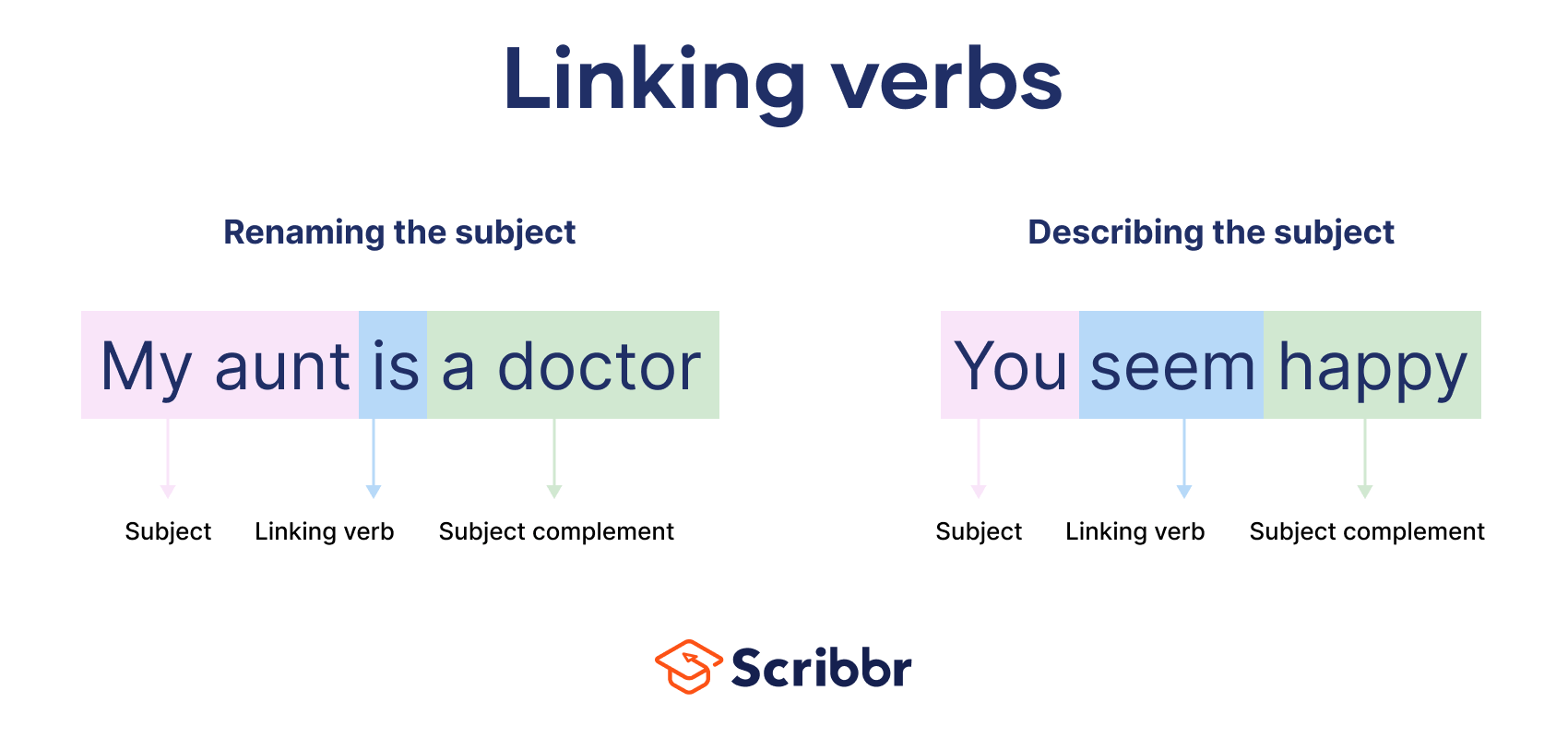What Is a Linking Verb? | Definition & Examples
A linking verb (or copular verb) connects the subject of a sentence with a subject complement (i.e., a noun, pronoun, or adjective that renames or describes the subject). For example, in the statement ‘Max is excited’, the verb ‘is’ links the subject ‘Max’ to the adjective ‘excited’.
Linking verbs are used to indicate conditions or states of being. They’re often contrasted with action verbs, which describe physical or mental actions (e.g., ‘run’). Some verbs can be classed as either linking or action verbs, depending on how they’re used.
Kishwar seems bored.
The finished painting will look great.
How are linking verbs used in sentences?
Linking verbs must follow subject-verb agreement and be conjugated for tense.
A linking verb is always followed by a subject complement (i.e., a word or phrase that identifies or describes the subject). There are two main types of subject complements:
- Predicate nominatives (or predicate nouns) identify the subject using a noun or noun phrase.
- Predicate adjectives describe the subject using an adjective or adjectival phrase.
This coffee tastes bitter.
The linking verb ‘be’ can also be used along with an adverb or prepositional phrase to indicate time or location.
The book is on the shelf.
- Peter seems tired.
- Peter is tired.
Linking verbs and stative verbs
Stative verbs describe states of being or perception. Many verbs can be classed as both linking verbs and stative verbs (for example, the sense verbs ‘taste’, ‘sound’, ‘smell’, ‘feel’, and ‘look’). However, not all stative verbs are linking verbs.
While linking verbs always connect a subject with a subject complement, some stative verbs do not. For example, in the statement ‘I recognise that woman’, ‘that woman’ is not a subject complement; it is a direct object receiving the action of the stative verb ‘recognise’.
They seem unimpressed. [linking and stative]
I appreciate your time. [stative]
Mark dislikes algebra. [stative]
- The flowers are smelling nice.
- The flowers smell nice.
Linking verbs vs auxiliary verbs
The verb ‘be’ can be used as either a linking verb or an auxiliary verb, depending on the context.
When used as a linking verb, ‘be’ connects the subject of a sentence to a subject complement that identifies or describes it. When used as an auxiliary verb, ‘be’ helps another (main) verb to indicate tense, mood, or voice.
The cat is sleeping. [auxiliary]
Linking verbs vs action verbs
Linking verbs are often contrasted with action verbs (also called dynamic verbs).
- Linking verbs indicate conditions or states of being.
- Action verbs refer to specific physical or mental actions or events.
Some verbs (including all sense verbs) can be classed as either linking or action verbs, depending on the context.
I tasted the cake.
That man looks interesting.
Ross looks at his phone when he is bored.
- I feel badly about the accident.
- I feel bad about the accident.
Other interesting language articles
If you want to know more about commonly confused words, definitions, common mistakes, and differences between US and UK spellings, make sure to check out some of our other language articles with explanations, examples, and quizzes.
Frequently asked questions
Sources for this article
We strongly encourage students to use sources in their work. You can cite our article (APA Style) or take a deep dive into the articles below.
This Scribbr articleRyan, E. (2023, December 19). What Is a Linking Verb? | Definition & Examples. Scribbr. Retrieved 15 December 2025, from https://www.scribbr.co.uk/verb/linking-verbs/
Aarts, B. (2011). Oxford modern English grammar. Oxford University Press.
Butterfield, J. (Ed.). (2015). Fowler’s dictionary of modern English usage (4th ed.). Oxford University Press.
Garner, B. A. (2016). Garner’s modern English usage (4th ed.). Oxford University Press.




